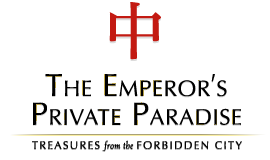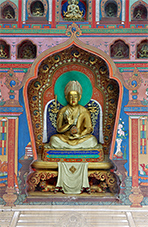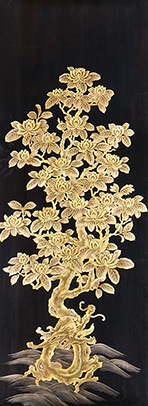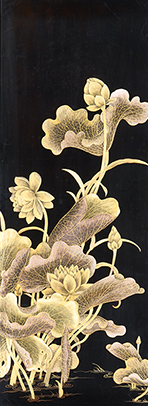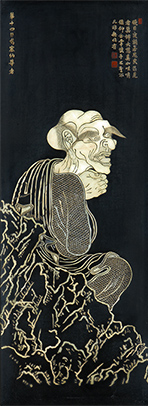The Emperor’s Private Paradise: Treasures from the Forbidden City June 11–September 11, 2011 Baker/Rowland Galleries
![Figure: Screen [detail]](media/image/art/emporer_flower_268.jpg)
Screen (sixteen double-sided panels) [detail], From Building of Luminous Clouds (Yunguanglou). Zitan, lacquer, jade, and gold. ©Palace Museum
When the last emperor of China, Puyi, left the Forbidden City in Beijing in 1924, the doors closed on a secluded compound of pavilions and gardens deep within the palace. Filled with exquisite objects personally commissioned by the eighteenth-century Qianlong (pronounced chee’en lohng) emperor for his enjoyment during retirement, the landscaped complex of twenty-seven lavish buildings lay dormant for decades.
Now for the first time, ninety objects from the Qianlong Garden and the Forbidden City—murals, paintings, furniture, architectural and garden components, jades, and cloisonné—are available for public viewing in the Emperor’s Private Paradise: Treasures from the Forbidden City.
The artworks crafted for the Qianlong emperor (r. 1736–96) reflect the refined vision of one of history’s most influential rulers, revealing his reverence for nature and his dedication to Buddhism, Confucian morals, and scholarly pursuits. A stroll through the exhibition provides a sampling of what it would have been like to be the emperor walking through his rooms and gardens, surrounded by objects of exquisite beauty and exceptional craftsmanship. Objects range from the elaborate to the quietly personal, from room screens rendered in brightly pigmented enamels known as cloisonné to calligraphy written in the emperor’s own hand.
A visually arresting, monumental jade and lacquer screen depicts each of sixteen luohan, or enlightened beings—the celebrated disciples of the Buddha—in a surprisingly grotesque manner, after an earlier painting by a master who saw them appear this way in a dream. The reverse side of the screen, long hidden from view due to its orientation flush with a chamber wall, is equally striking, with glorious botanical images painted in gold (shown left).
A spectacular Buddhist panel painted on silk (shown left) is radiant with color and glittering with gold. The work is a mandala, a Buddhist cosmogram, depicting a portion of the universe with deities and other supernatural beings arranged in a ritually auspicious design. In an innovative combination of two- and three-dimensional formats, painted figures sit nestled in glass-covered insets, dotting the piece like gemstones. The emperor is depicted at the center in gold as the Bodhisattva Manjusri.
With sides and a back panel made from zitan, a wood so hard and dense that it sinks in water, a magnificent throne features gold painting on lacquer, bamboo-thread marquetry, fine woodcarving, and jade and hardstone inlay.
Also included in the exhibition is one of the rare extant examples of imperial trompe-l’oeil mural painting, a fifteen-foot-wide work depicting women and children in a palace hall celebrating the New Year. The mural is one of only eight such surviving eighteenth-century works. Painted by Chinese court artists who had been trained by a European artist, the mural reflects a successful blending of European and Chinese traditions.
Conservation Makes Exhibition Possible
The Palace Museum began preparing these objects for exhibition in 2001. The Palace Museum and World Monuments Fund are currently restoring and conserving the site in Beijing so that the Qianlong Garden, complete with the objects now traveling, can open to the public in 2019. This exhibition, therefore, is a once-in-a-lifetime opportunity to see treasured artworks that will likely never leave China again.
Exhibition Sponsor
The Emperor’s Private Paradise: Treasures from the Forbidden City was organized by the Peabody Essex Museum in partnership with the Palace Museum and in cooperation with the World Monuments Fund and has been made possible through generous support from the Mandarin Oriental Hotel Group and American Express. Additional support was provided by the E. Rhodes and Leona B. Carpenter Foundation, the National Endowment for the Arts, and by ECHO (Education through Cultural and Historical Organizations), a program of the U.S. Department of Education. The exhibition was coordinated at the Museum by Laurie Winters, director of exhibitions.
Image credits
- Screen (sixteen double-sided panels) [detail], From Building of Luminous Clouds (Yunguanglou). Zitan, lacquer, jade, and gold. ©Palace Museum
- Panel with niches (hanging). From Cuishanglou. Zitan, painted and gilt clay, colors on silk. 65 ½ x 36 ½ x 1 ½ inches (166 x 93 x 3.7 cm). ©Palace Museum

The Emperor’s Private Paradise gives an unprecedented and in-depth analysis of the garden and its extravagant imperial interiors. Essays offer an overview of the history of Chinese gardens and the extraordinary reign of the Qianlong emperor, while contextualizing the importance of the Qianlong Garden and its artworks.
Catalogue available in the Museum Store and at mam.org/store.
